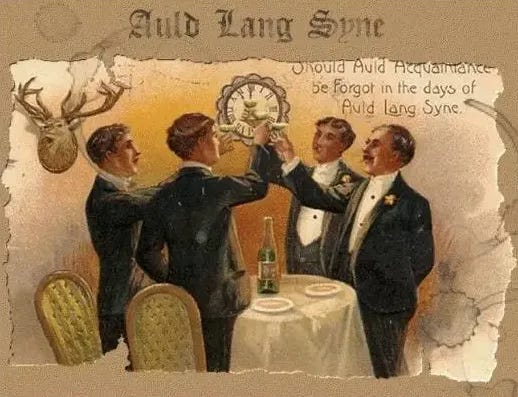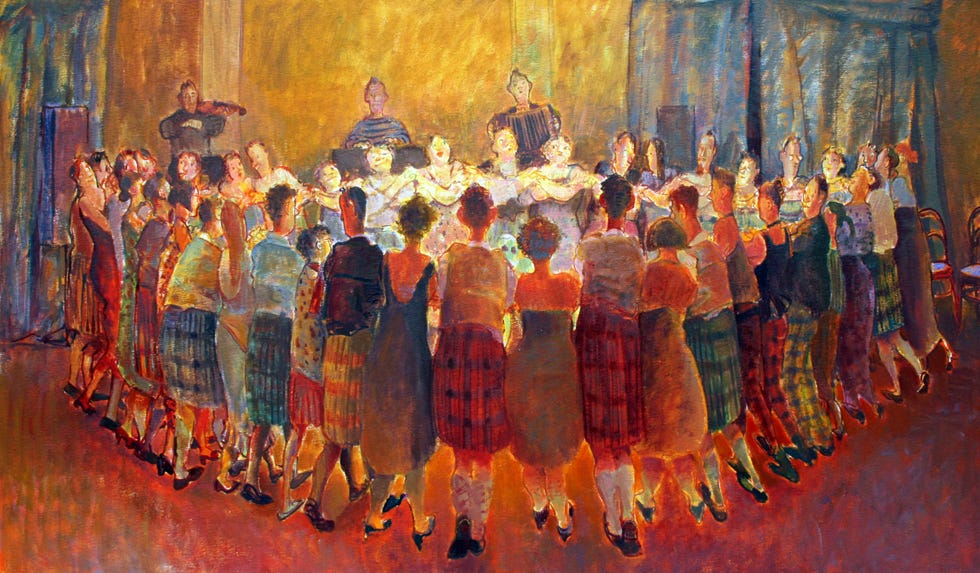The Enduring Allure of Auld Lang Syne
And so, as the clock strikes twelve and another year fades into memory, we sing—not perfectly, not solemnly, but earnestly. For auld lang syne, my dear, for auld lang syne.
As the hands of clocks lurch irrevocably toward midnight, and the air thickens with champagne-soaked sentimentality, mankind performs its annual ritual of temporal exorcism. Beneath glittering fireworks and the cacophony of noisemakers, a peculiar thing happens: the room grows still as people link arms in an awkwardly choreographed circle, swaying rhythmically, belting or mumbling, depending on temperament and familiarity, a song whose words are as old as they are, paradoxically, unknowable. This song is, of course, Auld Lang Syne—that enduring cultural relic, equal parts dirge and anthem, which flows through centuries of revelers like wine passed from cup to cup, leaving traces of memory and forgetfulness.
The poem at the heart of this ritual, penned by Scotland’s national poet Robert Burns in 1788, is itself an act of temporal defiance. Burns, both romantic and egalitarian, claimed he had merely “collected” the lyrics from oral tradition, imbuing them with a rustic authenticity that only a literary genius pretending to be a ploughman could convincingly assert. Whether he polished an old folk song or conjured the verses wholesale is, ultimately, irrelevant. What matters is the haunting idea Burns crystallized in his refrain: the past is worth remembering, not with the sterile precision of historical accuracy but with the warmth and imprecision of shared human emotion.
The titular phrase, auld lang syne, roughly translates to “old long since” or, more colloquially, “days gone by.” It is a poetic encapsulation of the yearning to hold on to fleeting moments, of friends and loves lost to the relentless entropy of existence. Yet, in Burns’s world, memory is not mere indulgence—it is resistance. It is the act of standing defiantly in the river of time, raising a metaphorical dram, and declaring, “We mattered.”
It is impossible to untangle the significance of Burns’s words from the melody that carries them—a tune so achingly simple, so universally hummable, that it feels as though it emerged not from a composer’s hand but from the Scottish soil itself. While the modern arrangement is credited to the Scottish composer William Shield, the melody’s roots dig deep into traditional Scots music, possibly predating even Burns. Its lilting rhythm—equal parts lullaby and lament—enfolds the singer in an emotional cocoon. It is a melody made for communal singing, for voices to stumble into unison and stumble out again, for crescendos of earnest enthusiasm to dissolve into tender mumblings.
The tune’s adaptability across cultures and generations is key to its immortality. Whether performed in the grandiosity of orchestral arrangements, with massed bagpipes and drums, the stripped-down intimacy of folk renditions, or the boozy revelry of amateur gatherings, it transcends linguistic and geographic barriers. A song that asks, “Should old acquaintance be forgot?” demands to be remembered, and the melody ensures it is.
What compels millions across the globe to sing Auld Lang Syne at the stroke of midnight on New Year’s Eve, regardless of their connection to Scottish heritage or familiarity with Burns? The answer lies in the human need for rites of passage. The song functions as a bridge, a symbolic crossing from the terrain of the old year—its triumphs, regrets, and banalities—into the uncharted wilderness of the new. The lyrics’ invitation to reflect on past friendships and shared cups of kindness resonates universally, even if no one quite knows what a “pint-stowp” is.
The act of linking arms during the song’s chorus is a particularly poignant gesture, a rare moment of physical and emotional unity in an increasingly fragmented world. Strangers become comrades; friends become family. In those few moments, the weight of the years feels lighter, the prospect of the future brighter, and the fragile beauty of human connection undeniable.
If Auld Lang Syne were merely a Scottish artifact, its influence would have likely waned. Instead, it has traveled the globe, metamorphosing as it went. In the United States, it became a fixture of Guy Lombardo’s New Year’s Eve broadcasts in the mid-20th century, cementing its place in the cultural lexicon. In Japan, the melody accompanies farewells and graduations, stripped of its original lyrics but retaining its emotional resonance. In South Korea, it evokes nostalgia in old-school broadcasts. Everywhere it goes, it adapts while remaining true to its core: a celebration of endings and beginnings, of memory and hope.
To sing Auld Lang Syne is to participate in a grand tradition of human longing. It is to admit, perhaps reluctantly, that time marches on, but to assert, defiantly, that we march too. The song’s power lies in its paradoxes: it is mournful yet uplifting, personal yet communal, specific yet universal. Burns’s words, paired with that indelible melody, remind us that in the end, what we carry with us are not things but moments, and the people who shared them with us. And so, as the clock strikes twelve and another year fades into memory, we sing—not perfectly, not solemnly, but earnestly. For auld lang syne, my dear, for auld lang syne!
Michael S. Rose is author of the New York Times bestseller Goodbye, Goodmen (Regnery), Ugly As Sin (Sophia Institute), The Art of Being Human (Angelico), Benedict XVI: The Man Who Was Ratzinger (Spence), and other books.






